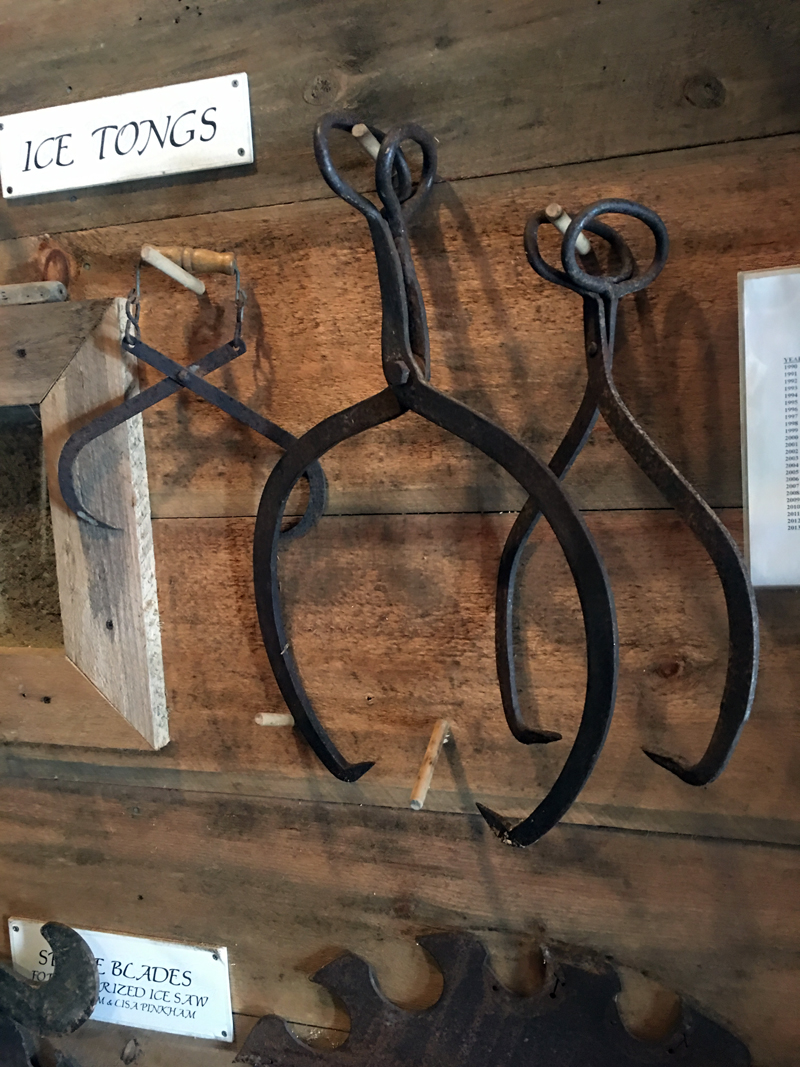
Ice tongs, such as these on display at the Thompson Ice Harvesting Museum in South Bristol, were typically used in Shirley Ross’ day to lift cut blocks of ice from a pond. (Christine LaPado-Breglia photo)
Shirley was born and lived on a small farm in the area called Moose Meadows near Feyler’s Corner, Waldoboro. She attended a one-room school; there were 31 of them at one time in town. One teacher taught all eight grades. Most children walked to school. Shirley remembers raking blueberries in the summer to pay for her school clothes.
On the farm, Shirley and her sisters were responsible for feeding the animals — cows, pigs, and laying hens. 4-H Clubs were organized for boys and girls ages 10 and up. They learned farm chores, and the girls also learned cooking, sewing, cleaning, and setting a proper table. One year Shirley was allowed to bring up and care for a calf, whose birth she was not allowed to witness. Boys and girls, to their great pleasure, were allowed to take part in the summer haying; they would ride on top of the hay wagon and tramp down the loose hay as it was forked on top of the load.
Winters were much more severe than today’s winters. Many feet of snow would fall and drift onto the roads despite snow-fencing installed some yards back in the fields. Shirley’s father would plow the snow, and when the drifts grew really high, he would use two trucks, one behind the other. When the snow on the road became hard-packed, the children would slide or ski sometimes half a mile down by their house, watching all the while with an adult for automobile headlights that might be approaching. Shirley says that not many cars were used in the wintertime.
The cold temperatures brought on very thick ice. After clearing the snow from part of a pond, people enjoyed skating and bonfire picnics. Most families had an ice house, where the winter harvest was stored for summer use. Several men would get together when the pond ice was sufficiently thick, and with long saws, cut through the ice which, at the time of harvest was about 18-20 inches thick. Cutting blocks off in half-chunks for easier handling, they would push them through the open water with long-handled tools and lift them out with tongs. The ice blocks then were stored in the ice house, one by one, surrounded by sawdust to keep them from freezing together and for insulation. The ice would last throughout the summer and be used in the ice-box refrigerator. The ice for Shirley’s family came from Storer’s Pond in North Waldoboro.
One of the best uses for ice was for making homemade ice cream. The ingredients were frozen in a metal container placed in a wooden bucket and rotated by turning a crank handle connected to a series of gears that turned a dasher inside the container. When the handle was cranked, the dasher rotated in the container to keep the ingredients — cream and perhaps strawberries — smooth and evenly chilled. Crushed ice was put into the bucket and surrounded the metal can. The right mix of salt and water had to be added to make the cream freeze. Children loved to turn the crank but soon tired when nothing happened, as it would take several minutes to freeze. One could tell the ice cream was ready when the crank was difficult to turn. When this happened, the cover was opened and the dasher was pulled out with lots of ice cream on it. Everyone wanted to eat the ice cream left on the dasher. Homemade ice cream was a special treat for children and grown-ups alike. It was most often made for large family gatherings or ice cream socials.
Radio was a major source of entertainment for people of the 1930s and 1940s. Shirley recalls sitting in front of the speaker listening intently each weekday evening to Tom Mix, Jack Armstrong, Captain Midnight, Terry and the Pirates, “Our Miss Brooks,” “The Shadow” for adventure stories, and George Burns, Gracie Allen, Jack Benny, and Fred Allen for comedy. President Franklin Roosevelt spoke often on the radio, telling about events of World War II such as Pearl Harbor, Dunkirk, and D-Day. He also spoke during the Depression about keeping folks’ spirits up during hard times.
When the Waldo Theatre opened in 1936, the citizens of Waldoboro had a first-class entertainment center. Westerns were shown every Saturday night, and it was thrilling to actually see the special treats like Shirley Temple and “Snow White and the Seven Dwarfs.” (Of course, there was no television at all.)
World War II for everyone was a very sad time. Many families were changed by men being drafted into the armed services, not finishing high school, and traveling to many parts of the world and sometimes returning wounded or not at all. War years were difficult for civilians, too. Many items were rationed — gasoline, sugar, and butter as examples. Shirley remembers blackout drills; a siren would be heard, and lights were extinguished, shades pulled, and blankets covered windows, all for the purpose of hiding from potential attacking enemy planes. There was a lookout tower in North Waldoboro; Shirley took her turn manning that tower and reporting any planes seen to the authorities. The war ended in Europe on May 8, 1945 — Shirley’s birthday. Japan’s surrender in August 1945 signaled the end in Asia. Great celebrations in every town she remembers, including in Waldoboro.
Shirley’s life since the end of World War II has, in her words, “brought many changes,” if not the end of wars. She mentions inventions to make life easier, more work and better pay, more opportunities for women, and much better health care.
Thank you, Shirley Ross!
Sources: The memories of Shirley Ross






